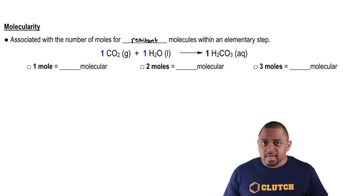Consider the reaction 4 NH3(𝑔) + 5 O2(𝑔) ⇌ 4 NO(𝑔) + 6 H2O(𝑔), Δ𝐻 = −904.4 kJ Does each of the following increase, decrease, or leave unchanged the yield of NO at equilibrium? (e) add a catalyst
Ch.15 - Chemical Equilibrium
Chapter 15, Problem 64
For a certain gas-phase reaction, the fraction of products in an equilibrium mixture is increased by either increasing the temperature or by increasing the volume of the reaction vessel. Does the balanced chemical equation have more molecules on the reactant side or product side?
 Verified step by step guidance
Verified step by step guidance1
Step 1: Understand Le Chatelier's Principle, which states that if a dynamic equilibrium is disturbed by changing the conditions, the position of equilibrium shifts to counteract the change.
Step 2: Consider the effect of increasing temperature on the equilibrium. For an endothermic reaction, increasing temperature shifts the equilibrium towards the products, while for an exothermic reaction, it shifts towards the reactants.
Step 3: Analyze the effect of increasing the volume of the reaction vessel. According to Le Chatelier's Principle, increasing the volume decreases the pressure, and the equilibrium will shift towards the side with more moles of gas to increase the pressure.
Step 4: Since both increasing temperature and volume increase the fraction of products, the reaction is likely endothermic and has more moles of gas on the product side.
Step 5: Conclude that the balanced chemical equation has more molecules on the product side, as both changes favor the formation of products.
Key Concepts
Here are the essential concepts you must grasp in order to answer the question correctly.
Le Chatelier's Principle
Le Chatelier's Principle states that if a dynamic equilibrium is disturbed by changing the conditions, the system will adjust to counteract the change and restore a new equilibrium. This principle helps predict how changes in temperature, pressure, or concentration will affect the position of equilibrium in a chemical reaction.
Recommended video:
Guided course

Le Chatelier's Principle
Equilibrium Constant (K)
The equilibrium constant (K) is a numerical value that expresses the ratio of the concentrations of products to reactants at equilibrium for a given reaction at a specific temperature. It provides insight into the extent of the reaction and whether the reactants or products are favored in the equilibrium mixture.
Recommended video:
Guided course

Equilibrium Constant K
Molecular Count in Reactions
In a balanced chemical equation, the number of molecules on the reactant side compared to the product side can influence the reaction's response to changes in conditions. If increasing temperature or volume shifts the equilibrium towards products, it suggests that there are fewer molecules on the product side, as systems tend to favor the side with fewer moles to reduce pressure or energy.
Recommended video:
Guided course

Molecularity in Reactions
Related Practice
Textbook Question
Textbook Question
Consider the reaction 4 NH3(𝑔) + 5 O2(𝑔) ⇌ 4 NO(𝑔) + 6 H2O(𝑔), Δ𝐻 = −904.4 kJ Does each of the following increase, decrease, or leave unchanged the yield of NO at equilibrium? (f) increase temperature.
1
views
Textbook Question
Consider the following equilibrium between oxides of nitrogen 3 NO(g) ⇌ NO2(g) + N2O(g) (a) Use data in Appendix C to calculate ΔH° for this reaction.
Textbook Question
Consider the following equilibrium between oxides of nitrogen
3 NO(g) ⇌ NO2(g) + N2O(g)
(c) At constant temperature, would a change in the volume of the container affect the fraction of products in the equilibrium mixture?
Textbook Question
Methanol (CH3OH) can be made by the reaction of CO with H2: CO(𝑔) + 2 H2(𝑔) ⇌ CH3OH(𝑔) (a) Use thermochemical data in Appendix C to calculate ΔH° for this reaction.
